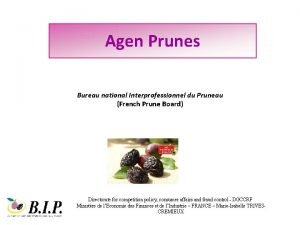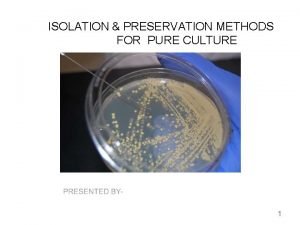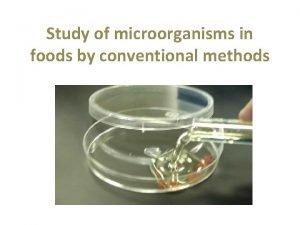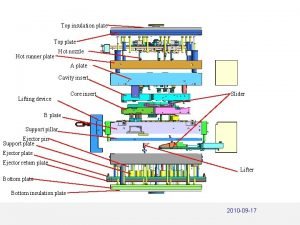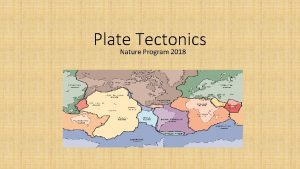From prune to plate processing Processing 28 processing











- Slides: 11

From prune to plate: processing

Processing 28 processing firms Ø 8 processing firms accounting for 80% of sales Ø 55% private companies / 44% cooperatives / 1% growers – processing firms Ø Average annual sales: 50, 000 t of which – France: 60% – Export: 40% Ø

Processing stages – Approval – Grading – Storage – Rehydratation – Packaging

Processing stages – Approval: allows the quality of a batch to be established. – Grading: involves classifying the prunes by size. It corresponds to the number of prunes per 500 g. The various grades and their commercial description 28/33 33/44 44/55 55/66 66/77 Giant Very Large Average 77/88 88/99 Cooking prunes Small cooking prunes

- Storage: the fruit is stored in warehouses kept at a constant temperature and humidity. – Rehydratation: the prunes are rehydrated by soaking them in water at 75/80° for 15 to 30 minutes. Agen prunes then have a 35% moisture content to provide the tenderness that today’s consumers demand. – Packaging: this may take different forms: 50 g, 250 g, 500 g, 1 kg, sachets, trays, cartons, boxes, baskets, etc.

The various grades The usual descriptions for prune grades are: - grade 33 -44 – “giant” = 33 to 44 prunes per 500 g. - grade 44 -55 – “very large”. - grade 55 -66 – “large”. - grade 66 -77 – “average”. Only prunes in these 4 categories may be called “Pruneaux d’Agen”. - grade 77 -88 – “cooking prunes”. - grade 88 -99 – “small cooking prunes”.

The different forms of prunes – – “Traditional” rehydrated prunes Tender or extra-moist prunes Half-baked prunes Organic prunes – – – With or without stones Flavoured (orange, vanilla, etc. ) Prune-based specialities (confectionary, etc. ) Juices Cream-based desserts Alcohol, etc.

A tense economic climate Ø European Union financial support for the prune industry has been regularly scaled down with total disengagement scheduled for 2013. Ø Production costs are constantly rising: drying (40% of expenses) in particular, takes the brunt of energy price hikes. Ø Tough international competition, especially from countries with low production costs (Chile, Argentina). Ø Lower consumption since the 2008 financial crisis coupled with lower sale prices. 8

The industry’s reactions Ø Improving competitiveness by cutting production costs (orchards and drying). Ø Better quality owing to the modernisation of production techniques and the awarding of the PGI. Protecting this high quality (work ongoing with the SCL – Labo 33), together with an inter-professional communication strategy. Ø Highlighting the nutritional values of Agen prunes. Ø Diversifying markets by innovation. 9

A guarantee of authenticity, nutritional benefits Two spearheads of the industry’s protection and win-back plan: Ø Ensuring traceability of the geographical origins of prunes to prevent any fraud on Agen prunes. Ø Proving the beneficial effects of Agen prunes on certain chronic or metabolic diseases in line with major public health concerns. 1 0

Thank you for your attention
 Sourcetree prune
Sourcetree prune Prune and search
Prune and search The bureau prune
The bureau prune Prune-and-search
Prune-and-search Sweep and prune collision detection
Sweep and prune collision detection Spread plate vs pour plate
Spread plate vs pour plate Streak plate method
Streak plate method A denser oceanic plate collides with a continental plate
A denser oceanic plate collides with a continental plate Pour plate method steps
Pour plate method steps Oreo plate tectonics
Oreo plate tectonics Neighborhood processing in digital image processing
Neighborhood processing in digital image processing Top-down vs bottom-up processing
Top-down vs bottom-up processing


